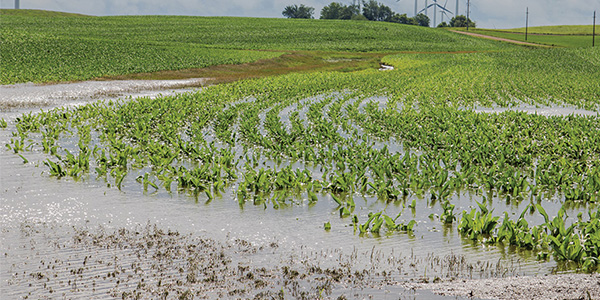AGRONOMICSUPPORT
YOU CAN TAKETO THE FIELD
Protect Against a Nitrogen Deficiency in Corn
Proven Strategies to Keep Yield Potential on Track
Nitrogen is one of the most yield-critical nutrients in corn production. A shortfall, whether from leaching, timing, or underapplication, can cost bushels fast. Knowing what to look for, when to act, and how to respond gives you a leg up on protecting your crop and your ROI.
Agronomist Justin Schneider emphasizes that nitrogen is the lifeblood of a corn plant. But because it's mobile and sensitive to environmental conditions, it's also one of the most difficult nutrients to manage. Add in heavy rainfall or sandy soils, and nitrogen can quickly leave the root zone through leaching or denitrification, leaving plants short during critical growth stages.Spotting the Signs: How Nitrogen Deficiency Shows Up in the Field
Nitrogen-deficient corn is often easy to recognize if you know what to look for. The most common symptom is a pale yellowing that starts at the tip of the lower leaves and moves up the midrib in a distinct “V” shape. Other signs include:
- Stunted growth or poor vigor
- Uneven plant height or color across rows and zones
- Deficiency showing first in low-holding-capacity soils
- Stress symptoms becoming visible during the V4–V6 stages
While discoloration is a helpful clue, it's not definitive. Schneider cautions against assuming yellowing is always due to nitrogen loss, tissue tests and soil nitrate testing offer critical confirmation.
"When corn in low spots yellows after a rain, it's easy to panic," Schneider says. "But up to V6, corn only uses 20 to 25 lbs. of nitrogen. A small rain event isn’t usually the issue. It’s when you get 5+ inches over a few weeks that supplemental nitrogen may be needed."

The two primary ways nitrogen loss in corn occurs are via leaching and denitrification of soil. With leaching, nitrates move below the root zone due to drainage within the soil profile. Leaching can be amplified by heavy rainfall events, with rapid drainage patterns like those found in tile-drained fields upping that risk.
Confirming the Diagnosis: Tools to Back Up Your Scouting
Visual scouting is a great starting point, but data should drive your decisions. Use these tools to build a complete picture:
- Soil nitrate testing to measure residual N levels in the root zone
- Tissue sampling to check plant uptake status
- Chlorophyll sensors or drone imagery to identify stressed areas early
- Weather and field history to anticipate patterns and risk zones
Using multiple methods allows for smarter, more confident in-season adjustments.
Preventing Deficiency: Build a Season-Long Nitrogen Plan
You can’t predict the weather, but you can prepare for it. The key is to create a nitrogen program that adapts to conditions and soil variability. Start with a base application, and then tailor your plan with:
- Split applications to spread risk and improve efficiency
- Sidedressing at V4–V6 to match crop uptake timing
- Stabilizers and enhanced efficiency fertilizers (EEFs) to limit loss from volatilization or leaching
- Soil-type-specific management, particularly in sandy or tile-drained fields
"If possible, it’s best to split apply nitrogen fertilizer," Schneider advises. "And in early-planted fields that will likely catch more rain, consider applying an extra 10 to 20 lbs. of N."
Rescue Applications: Midseason Options That Protect Yield
Even the best-laid plans need backup. When nitrogen deficiency symptoms appear late, especially around tasseling, you still have options. The crop’s nitrogen demand peaks between VT and R1, making this the best window for rescue treatments.
Effective rescue methods include:
- Foliar or UAN applications to quickly deliver nitrogen
- Drop nozzles or Y-drops on high-clearance sprayers for in-canopy precision
- Aerial applications for broad, fast coverage when ground rigs can’t enter fields
Supplementing nitrogen during fungicide applications is also a smart way to dual-purpose the pass. Just be sure to evaluate expected yield return before making the investment.
Hybrid Selection: Get More from Every Pound of Nitrogen
Maximizing your nitrogen ROI starts with hybrid selection. Some LG Seeds corn hybrids are bred with high nitrogen use efficiency (NUE), meaning they convert applied nitrogen into yield more effectively.
Work with your LG Seeds agronomist to:
- Match hybrid NUE scores to your fertility and application strategies
- Choose hybrids with stronger early vigor in N-limited soils
- Design a nitrogen plan that aligns with the hybrid's developmental curve
Don’t Forget Sulfur: Nitrogen’s Partner in Yield
Schneider reminds growers that sulfur is essential to unlocking nitrogen’s potential. "Sulfur is nitrogen’s partner in crime. It’s the Robin to nitrogen’s Batman," he says. Sulfur helps corn metabolize and use nitrogen more efficiently.
Like nitrogen, sulfur is mobile in the soil and can leach away in wet conditions. Be sure to apply proper sulfur rates, especially in high-yield systems, to get full value from your nitrogen investment.
Manage Nitrogen Like Yield Depends on It (Because It Does)
From scouting and soil testing to hybrid choice and rescue passes, nitrogen management is never one-size-fits-all. But with the right tools and strategy, you can reduce loss, boost efficiency, and protect your yield potential no matter what the season throws at you.
Want help building a nitrogen plan for your acres? Talk with your local LG Seeds agronomist today.
Sources:
- Roth, Richard. Navigating Nitrogen Management in West Spring Conditions — Nitrogen Loss Mechanisms. Iowa State University Extension and Outreach. Integrated Crop Management. May 28, 2024. https://crops.extension.iastate.edu/blog/richard-roth/navigating-nitrogen-management-wet-spring-conditions-%E2%80%93-nitrogen-loss-mechanisms. Retrieved 6/28/24.
- Fernandez, F.G., Nafziger, E.D., Ebelhar S.A., and Hoeft, R.G. Managing nitrogen, Chapter 9. Illinois Agronomy Handbook. 2009. https://extension.illinois.edu/global/agronomy-handbook. Retrieved 6/28/24.





